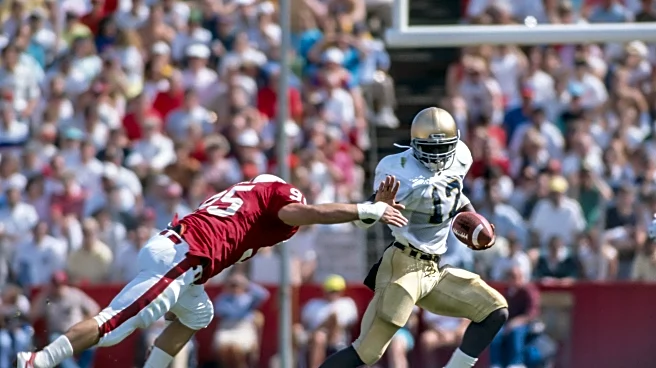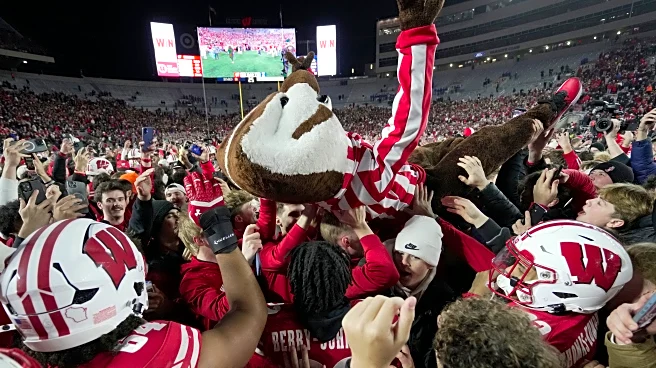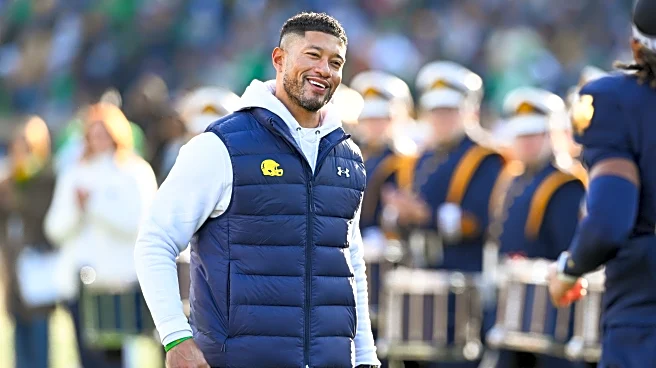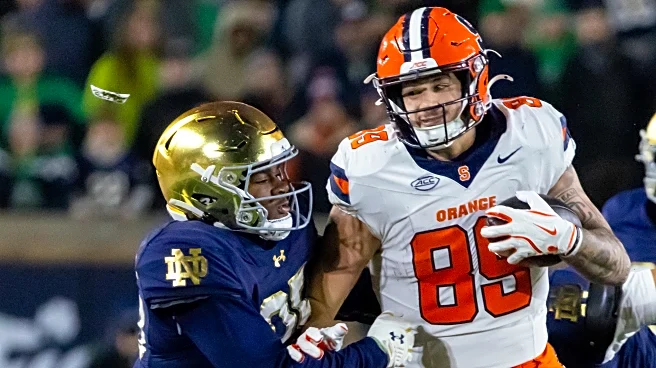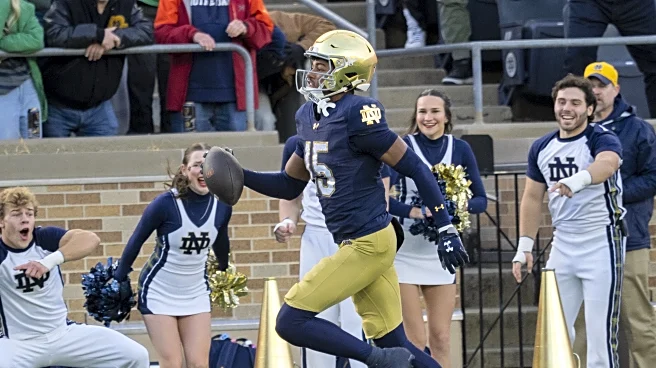This week’s Throwback Thursday takes us back to a tense afternoon in Palo Alto, when the top-ranked Fighting Irish found themselves in a battle they never expected. Notre Dame arrived at Stanford Stadium
favored by three touchdowns, but the upset-minded Cardinal pushed the Irish to the limit — proving that sometimes the biggest tests come when you least expect them.
In the spirit of Thanksgiving, it feels fitting to celebrate the resilience, teamwork, and heart that defined this game. Just like on the field, the moments that bind us together — the moments when we dig deep and support one another — are what matter most.
Here’s the story of the Stanford Scare — a game where heart outshined hype, from Vol. 131, No. 11, 1989 Football Review, from the Scholastic Magazine, written by Brian McMahon.

Stanford Scare
Notre Dame struggles to overcome a serious challenge mounted by the upset-minded Cardinal
by BRIAN MCMAHON
Stanford Stadium was in a frenzy. Notre Dame was in a battle.
Cardinal junior running back Tommy Vardell had just crashed over the right side for a two-point conversion, bringing the score to a 14-14 deadlock with a quarter and a half to play. The Cardinal had played the top-ranked Irish close all afternoon, even leading 6-0 after the first quarter, but this marked the first time that the Stanford fans had really come to life.
Through two and a half quarters, one felt that the Irish would eventually explode, burying the Cardinal as their position as three touchdown favorites indicated they should. Now, with the score tied and the Irish showing few signs of life, upset seemed plausible.
Stanford’s John Hopkins teed up the ball to kickoff while most of the Cardinal fans were still basking in the glow of the score. He booted it to the left hash mark on the Notre Dame 18 where it was caught by Raghib
“Rocket” Ismail. Rocket took the ball and blew 66 yards to the Stanford16, where he was run out of bounds by Alan Grant.
Four plays later, Irish fullback Anthony Johnson bulled into the end zone from one yard out. Craig Hentrich converted the PAT and Notre Dame, in less than a minute and a half, had regained the lead and summarily
ended Stanford’s upset hopes on the way to a 27-17 victory before a sellout crowd of 86,019.
When they tied it up and the stadium got involved,” Notre Dame Head Coach Lou Holtz said afterward, “our team responded. Something was on our sideline when it became 14-all. Something in here,” he boasted,
pointing to his heart.
“It made me feel good.”
The Irish struggled offensively in the first quarter, netting just 53 yards and making just one first down. Thirty-five yards in penalties didn’t help either, one of which kept a drive alive for the Cardinal that led to Stanford’s first score.
A 47-yard field goal attempt that Hopkins sent way short was called back when the officials whistled Notre Dame’s D’Juan Francisco for roughing the kicker. Four plays later, Hopkins punched a 34-yard shot for a 3-0 Stanford lead.
The drive provided an indication of things to come from the Cardinal offense. Freshman quarterback Steve Smith went to the air ten times on the 14-play drive, completing seven passes, only one of which went for more than ten yards. All afternoon, Smith nickle-and-dimed the Irish defense en route to 39 completions for 282 yards on 38 attempts. The 68 attempts were a Stanford and Pac-10 Conference record.
Two and a half minutes later, Hopkins kicked a 42-yard field goal and Stanford led by six heading into the second quarter. The score was set up by a shanked punt by Hentrich, which gave Stanford the ball on the Notre Dame 32.
Notre Dame got on the board early in the second stanza. It took the Irish just four plays to go 64 yards, keyed by runs of 25 and 38 from Anthony Johnson and Tony Rice. Johnson carried into the end zone from seven yards out and Craig Hentrich’s PAT gave the Irish the lead, 7-6.
Stanford’s propensity to pass caught up with them seven minutes later. Notre Dame’s defensive philosophy against a pass-oriented offense is to avoid being burned by the long pass and hit the receiver where he catches the ball, the theory being that an offense putting the ball in the air that much will self-destruct.
Smith’s thirty-fifth pass of the first half set up Notre Dame’s second touchdown. The pass, intended for senior tight end Jim Price, was deflected into the hands of Francisco, who returned it 20 yards to the Stanford 32.
“We knew they’d pass a lot,” said Irish safety Pat Terrell, who finished with two interceptions on the day. “They were dropping the ball off in the flats, going to the sidelines. We didn’t get frustrated.”
Nine plays after Francisco’s interception, Rice pitched to sophomore fullback Rodney Culver, who went in untouched from the two for his second touchdown of the season. Hentrich’s kick made the score 14-6 entering
the second half.
Stanford’s game-tying score halfway through the third quarter came at the end of a 79-yard drive when Smith found junior receiver Ed McCaffery in the end zone from five yards out. On the previous play, third and goal from the ten, Stanford got a break when Irish cornerback Stan Smagala was called for interference for tripping Stanford receiver Chris Walsh.
Cardinal Head Coach Dennis Green, behind by two, elected to go for the tie. Smith’s pass for Jon Pinckney fell incomplete, but the Irish were called for interference again. This time Francisco was the culprit, setting up Vardell’s one-yard plunge to tie the score. That set the stage for Ismail’s heroics.
Up 21-14, the Irish threatened late in the quarter but failed to earn a first down on fourth and one from the five. The quarter ended with Notre Dame up by a touchdown.
The fourth quarter opened with the Irish driving from the Stanford 40. Hentrich kicked his first of two fourth-quarter field goals, a 20-yard kick that widened the lead to 24-14.
Stanford answered four and a half minutes later when a 70-yard drive culminated in Hopkins’ third field goal of the game, this one from 27 yards. Smith threw on nine of the drive’s 12 plays, completing six, but
couldn’t engineer a touchdown, as the Irish defense tightened deep in its own end. The Cardinal would not threaten again.
Terrell picked off Smith passes on each of the Cardinal’s last two drives, the first of which led to an 18-yard field goal by Hentrich and the last coming with just over a minute left, preserving the Irish’s 27-17 victory.
“It was a hard fought, difficult game,” Holtz concluded. “I wasn’t surprised they played that well. Dennis Green and his coaches deserve all the credit in the world.
“We played well on defense,” he continued. “Our plan was to cover them and let them dump it off or mix it up.”
Irish linebacker Donn Grimm put Smith’s apparent success into perspective. “We didn’t want to blitz a lot because they are so good man to man,” he said. “We played a zone to avoid the big play, dropping eight
guys back. He (Smith) wasn’t taking time to throw but we had a good rush for the defense we played.”
“Notre Dame is a fine team,” summed up Green afterward. “They don’t make mistakes and they have good balance … good teams make key plays.”
At Stanford Stadium that day, those qualities proved too much to overcome for the gritty Cardinal.
In the end, Notre Dame walked out of Stanford Stadium with a 27–17 victory, but the scoreboard hardly captured the fight it took to earn it. From clutch defensive stands to Pat Terrell’s late interceptions and Rocket Ismail’s momentum-shifting return, the Irish refused to fold when adversity hit hardest.
Games like this remind us that champions are defined not by perfection, but by resilience — by rising when challenged and finishing together. That spirit reflects so much of what we celebrate this Thanksgiving season: gratitude for community, strength in unity, and the belief that together we can overcome anything.
As we gather with family and friends, may we carry forward that Fighting Irish determination and heart.
Wishing you all a joyful, peaceful, and blessed Thanksgiving.
Cheers & GO IRISH!
